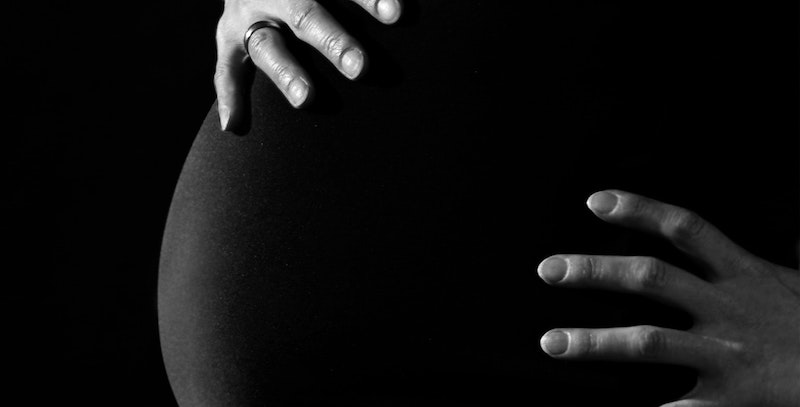What the Shadowy History of Women’s Health Tells Us About Its Uncertain Future
Clare Beams on the Dark Legacy of a Purported Pregnancy Miracle Drug
The history of women’s medicine is a large and shadowy room, with whole back portions almost entirely dark—and sometimes, our post-Roe world has shown us, tendrils of this darkness still steal into the present. I was wandering in that dark by choice, though, doing research for my first novel, when I first came across a reference to diethylstilbestrol.
DES, as it’s often abbreviated, is a synthetic estrogen that was widely prescribed to prevent miscarriage from the 1940s through the 1970s, when the FDA issued a statement against its use during pregnancy, but I’d never heard of it before. The article I’d found called it the silent thalidomide, which summoned a memory of haunting images I’d seen of children born without limbs after in-utero exposures, and of the Sylvia Plath poem (“The indelible buds./ Knuckles at shoulder-blades…”). The silent part in DES’s case was that the portions of the body affected were invisible, mostly confined to the reproductive tracts of the female babies who’d been exposed in the womb, and often undetected for years.
That the Smiths can’t have intended that crushing does not change the fact that they do, must, bear responsibility for it.DES had been pioneered by a husband-and-wife researcher team, Olive Watkins Smith, a biochemist, and her husband George Van Siclen Smith, an obstetrician. Olive Watkins Smith was the primary author of the 1949 paper (“Diethylstilbestrol in the Prevention and Treatment of Complications of Pregnancy”) that became the catalyst for DES’s nationwide prescription to pregnant patients. She was the first woman to receive her PhD in biochemistry from Harvard, in 1928, and she went on to direct the Fearing Research Laboratory at the Free Women’s Hospital in Boston for decades.
For a recent Women’s History Month, Brigham and Women’s Hospital’s Clinical Research News department posted a glowing, clear-eyed picture of her, a laudatory caption. She went into research because her surgeon father didn’t believe women should be physicians; she got her first job at the Fearing Laboratory when George Van Siclen Smith hired her, and they married just a year later. Peering through these outlines of her career, around the father and the husband in the way, I can catch sight of a vast fortitude. She must have fought very hard, always, to move herself forward.
Her intended destination: groundbreaking achievement in the field of endocrinology. Over the course of the 1930s, she and her husband (who was a medical professor at Harvard and a gynecologist at the Free Women’s Hospital) produced several theories that built on each other. First, in 1936, they mapped intricate relationships between pregnancy hormones: increased levels of estrogen, they theorized, were responsible for the pregnant body’s efficient use of HcG (human chorionic gonadotropin, a hormone secreted by early embryonic tissue) to grow the corpus luteum, a cyst on the ovary that in turn secretes the progesterone necessary to sustain a pregnancy. Then, in 1941, the Smiths showed that deviations from expected hormone levels—enough estrogen, enough progesterone—in the urine of pregnant women were associated with high blood pressure, preterm delivery, miscarriage, and stillbirth later on.
These scientific breakthroughs led the Smiths stepwise to catastrophe. Following their own logic, they came to believe that if women’s hormones could only be regulated—evened out, controlled, made to behave in expected and orderly ways—all would be well, or at least better. They only needed to find a substance potent enough to allow for such control.
DES practically fell into the Smiths’ open hands. It must have felt providential.
The drug wasn’t actually the Smiths’ discovery: it had been created in Britain by Sir E. Charles Dodds in 1938 as a short-term treatment for bothersome menopause symptoms. But the Smiths were the ones to grasp that it might be useful for stabilizing pregnancy hormones, and to conduct and publicize a study supporting this case. After the publication of their 1949 paper, physicians began prescribing the drug widely to their pregnant patients: to those who had experienced repeated miscarriage, but also prophylactically. As the kind of just to be sure so many pregnant women crave.
Anyone who was really, scientifically looking could have seen early glimmers of trouble. In 1938, the same year Dr. Dodds synthesized DES, a British study found that mice exposed to the substance developed mammary tumors; more such studies appeared in 1940. Other research suggested that too-high levels of artificial estrogen might lead to increased, not decreased, pregnancy complications. Olive Watkins Smith addressed these concerns in that 1949 paper by asserting they were risks related to diethylstilbestrol overdose, and that the dosages she suggested should be carefully adhered to. But there were fault lines even in that paper itself.
The Smiths’ studies had no control group and were not double-blind. They compared one group of pregnant women with previous miscarriages to previous studies of entirely different groups of pregnant women with previous miscarriages. There was no real way of knowing if the differences they saw were due to diethylstilbestrol. The Smiths, though, must have been seduced by the story they themselves were telling—that steps could be taken to control pregnancy, to steer it around disaster.
And they seduced the whole world with it. Their story’s power drowned out doubts for a long time. In 1953, a double-blind, controlled, randomized trial showed that in fact diethylstilbestrol was ineffective at preventing miscarriage—but the drug continued to be prescribed to pregnant women. In 1959, the FDA banned the use of DES in stimulating poultry growth because high levels in chicken meat were leading to side effects in humans—breast growth in males among them—the drug still, astonishingly, continued to be prescribed to pregnant women.
Finally, in 1971, the immense harm beneath the Smiths’ seductive story fully surfaced. A.L. Herbst et al published a paper in the New England Journal of Medicine linking use of DES in pregnancy to much higher rates, for the female babies born to those mothers, of early-in-life clear cell adenocarcinoma, a rare vaginal cancer. The FDA, while it stopped short of banning DES, issued a bulletin to physicians saying it was contraindicated for use in pregnant patients.
But terrible damage had already been done. In the decades since the FDA’s bulletin, the female babies of the women who were treated with DES have demonstrated higher than normal rates of breast cancer, of malformations of the reproductive tract, of infertility and ectopic pregnancy and miscarriage and preterm labor, in addition to clear-cell carcinoma. While these seeds were sown in utero, they were sown on the inside, so it took time for their effects to be felt, time that allowed many more seeds to plant themselves. It’s estimated some 5 to 10 million pregnant women and their babies were exposed to DES, and these women and their descendants continue to advocate for both disclosure and justice today.
After learning this story, I couldn’t stop thinking about its tragedy. I have two daughters, and pregnancy made me very anxious; I wanted a guarantee of safety so badly that if someone had seemingly offered one, I might have jumped at it, so if the timing had been different I suspect I’d have been vulnerable to the kind of reasoning doctors used in prescribing DES. I immediately empathized with the women affected in a bone-deep way. I also found that I couldn’t stop thinking about how the tragedy came about.
The Smiths can’t have wanted the disaster to happen, of course; they were trying to understand the female body and its processes, which had been shrouded in mystery for centuries. The irony seems especially sharp when it comes to Olive Watkins Smith, because the very attributes that would have allowed her to achieve might also have made her unwilling to question the groundwork of that achievement, once she’d laid it. The world, after all, must always have been so quick to do all questioning for her. When you’ve spent your whole life warding off doubts, you might be slow to spot the one doubt, in the sea of them, that should stop you.
Another dimension of the irony: as a woman, Olive Watkins Smith had authored a theory about women’s hormones and their swings, about the kind of body she herself occupied and its many possible needs for correction. She believed that theory, advocated for it. And then—because Olive Watkins Smith lived until 1981—she must have watched in horror as its repercussions emerged. She’d have looked back at the path she had forged and seen what she had crushed beneath it. That the Smiths can’t have intended that crushing does not change the fact that they do, must, bear responsibility for it.
My new novel The Garden isn’t based in any kind of fact-related way on this terrible corner of history—but it did emerge, in part, from my inability to put the women affected out of my mind. And from the question of why seeing any kind of truth about women’s bodies was so hard to begin with, what made the darkness thick enough to hide the path for so long.
I don’t think that darkness has fully lifted yet from women’s lives, as evidenced by the way some of our current lawmakers are discussing women’s bodies even now, every day. So many kinds of harm can come from trying to control what one doesn’t fully understand. The sometimes deliberate not-knowing that predated the Smiths and has outlasted them—I worry about what new catastrophes might occur under its cover.
__________________________________

The Garden by Clare Beams is available from Doubleday Books, an imprint of Knopf Doubleday Publishing Group, a division of Penguin Random House, LLC.




















